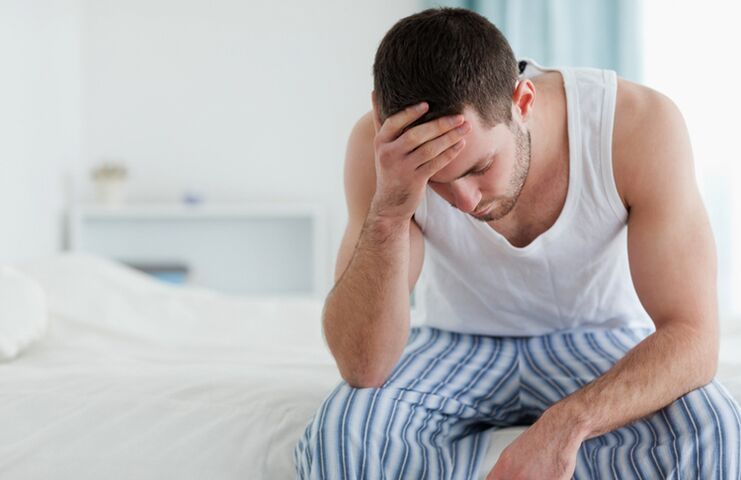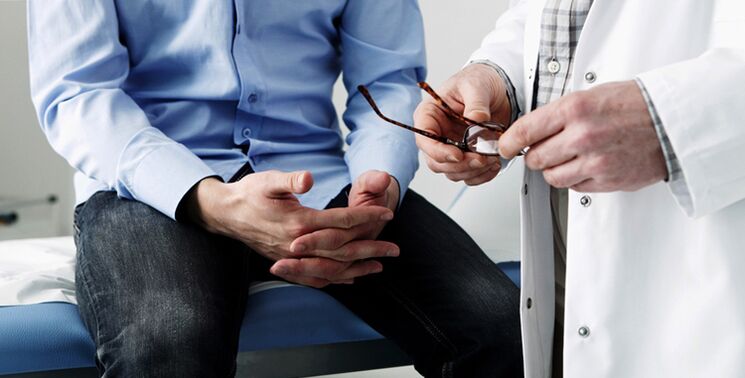The prostate is a gland in the male body. The normal parameters of a healthy organ are 2. 5-4. 5 cm long and 3-4 cm wide. It consists of glandular and muscular tissues and is formed at the age of 23, when the accumulation of hormones increases. The glandular or secretory tissue produces a special (secret) fluid which is released at the time of ejaculation and which is a component of semen.
The secret of the prostate has an alkaline reaction and ensures the vital activity and mobility of sperm, protecting them from the acidic environment of the vagina.
What is prostatitis
It is an inflammation of the prostate, which is only found in the male body and is involved in the production of the male sex hormone. The ligaments connect the gland to the pubic junction between the bones, its base converges with the bladder and surrounds the initial section of the urethra.
Located in the pelvis, the prostate is separated from the rectum by a thin septum of connective tissue. This anatomical location of the prostate explains the complaints that appear when it becomes inflamed and enlarged. The gland presses on the urethra, causing poor urine flow.
Compression of the rectum causes constipation. The location near the perineum causes pain in this area.
Assign acute and chronic prostatitis.
Acute prostatitiscan be caused by various bacteria:
- Escherichia coli.
- Staphylococcus aureus.
- Enterococcus.
- Pseudomonas aeruginosa.
- Enterobacteriaceae.
The presence of these pathogens in the body of a healthy person is natural and not harmful. But with a decrease in immunity, bacteria are activated, penetrate the tissues of the gland and cause acute inflammatory processes, which are manifested:
- An increase in temperature, both of the whole body and rectally (in the rectum). In addition, the rectal temperature is often higher than in the axillary region.
- Complaints of chills, fever.
- The appearance of pain in the groin, scrotum, anus.
- Frequent and painful urination (cramps, burning). Cravings become more frequent at night.
- General poisoning. Weakness, muscle and joint pain, headaches.
- Urine color change. It becomes cloudy, sometimes with an admixture of blood.
- Discharge from the urethra.

A slow or advanced acute process that lasts more than 3 months leads tochronic form.It is characterized by:
- Pain in the genital area.
- Violation of urination.
- Sexual disorders.
Main reasons
- Urinary tract infections. For a long time they can go unnoticed. The normal microflora of the genitourinary system copes with the pathogenic flora for some time. But as a result of hypothermia or any other adverse condition, an aggressive microflora begins to prevail and inflammation begins.
- prostate congestionis an important risk factor. A sedentary lifestyle, hemorrhoids, constipation - these factors lead to blood stagnation. Updated and oxygenated arterial blood practically ceases to circulate in the pelvic organs. Intracellular respiration decreases and the infection becomes a sovereign mistress.
- Irregular sex life, - when periods of increased sexual activity are replaced by prolonged abstinence. Frequent ejaculations, as well as their limitation, lead to stress and dysfunction of the secretory function. With the above reasons, this gives the prerequisites for the start of the inflammatory process.
- Obesity. The metabolism is disturbed, which leads to atherosclerosis and the deposition of cholesterol.
- hypothermiacan lead to a decrease in immunity.
- Alcohol and tobacco abuseleads to a narrowing of the large vessels that supply the prostate.
- Lack of physical activitydoes not allow the muscles of the prostate to function and throws the secret completely.
The first signs of prostatitis in men
- Weak urine stream at close range.
- Difficulty urinating with pain.
- Intermittent flow.
- Prolongation of the urination process.
- Incomplete emptying of the bladder.
- Frequent calls at night.
Symptoms and signs
There are two phases in symptoms: latent (hidden) and active. In the latent phase, which can last for years, there are almost no complaints. There is a slight feeling of discomfort in the scrotum, anus or glans penis.
Men try to ignore it or see it as overwork. Over time, the pain intensifies, it becomes more and more difficult to empty the bladder. This indicates that the latent phase has turned into the active phase, the inflammation has started to progress, and clear signs of disease have appeared:
- Unpleasant sensations during the act of defecation.
- Stringy discharge from the urethra during bowel movements.
- Burning in the perineum and urethra.
- Perceptible power problems.
- Quick ejaculation.
- The bladder empties partially and with difficulty.
- Problems of a psychological nature.
- Urination is repeated and painful with a stringy discharge.
- The process of emergence of an erection becomes long.
Diagnostic
- History taking. The doctor finds out all the complaints that the patient makes. Time of first symptoms. The presence of other diseases. Finds details of sexual activity, the presence of a permanent partner and other information necessary for an accurate diagnosis.
- Digital rectal examination of the prostate. Before the examination, the patient is given a microclyster to clean the intestines. Palpatory examination allows you to determine the increase and pain in the organ. As a result of prostate massage, part of the secret is released, which is given to the laboratory for research. The result allows you to determine the microflora of the gland and the sensitivity of pathogenic microorganisms to drugs.
- ultrasound. This examination determines the size of the prostate, its density and its structure. For a more detailed examination, a transrectal ultrasound is used. The tip of the device is inserted into the rectum, allowing part of the intestine and seminal tract to be checked.
- Cystoscopy. The procedure is performed using an endoscope. A thin probe with a camera is inserted into the urethra, allowing the bladder and gland to be viewed on the screen. Depending on the indications, they can do a biopsy (removal of tissue for analysis).

Laboratory studies are also carried out:
- General blood test (increased number of leukocytes).
- Urinalysis (leukocytes, erythrocytes and proteins are present in the samples).
- Bakposev on the microflora is taken from the urethra (susceptibility to antibiotics is determined).
- Semen analysis (motility, activity and accumulation of spermatozoa, state of reproductive function).
Methods and scheme of treatment of prostatitis
The treatment is complex. Includes preparations of various directions and actions, as well as massage, physiotherapy and therapeutic exercises.
Medications prescribed:
- Broad-spectrum antibiotics (affect pathogenic microflora).
- Alpha-blockers normalize the production of urine, improve the blood filling of the pelvic organs and reduce pain.
- Muscle relaxants.
Treatment also includes:
- Prostate massage (helps eliminate fluid retention and swelling). Acute infectious prostatitis is a contraindication to the procedure.
- Physiotherapy (electrophoresis, electrical stimulation, magnetic and laser therapy).
- Physiotherapy.
Only a doctor can prescribe medication after receiving these tests!
Prevention
- To prevent prostatitis, it is recommended to lead a mobile lifestyle. Walking, running, swimming, playing tennis are good for your health. Strength sports and cycling should be limited.
- Go on a diet. Eat foods rich in vitamins and minerals. Do not abuse alcohol and nicotine, limit the consumption of pickles and smoked meats.
- Caution in choosing a sexual partner to avoid sexually transmitted infections.
- Regular sex life.
Following these simple preventative measures will keep you healthy for many years.























